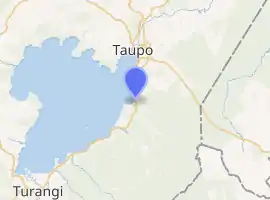Waitahanui
Waitahanui is a village in the Taupo District, Waikato region, New Zealand.[1] The village is on the eastern shore of Lake Taupo, 14 km (9 mi) south of the district seat of Taupō .
Waitahanui | |
|---|---|
Village | |

| |
| Coordinates: 38.794°S 176.076°E | |
| Country | New Zealand |
| Region | Waikato |
| Territorial authority | Taupo District |
| Ward | Taupō-Kaingaroa |
| Population (2018) | |
| • Total | 549 |
| Postcode(s) | 3378 |
Waitahanui Marae and Pākira meeting house is a meeting place for the Ngāti Tūwharetoa hapū of Ngāti Hinerau and Ngāti Tutemohuta. The Waitahanui Bridge site is also a meeting place for the Ngāti Tūwharetoa hapū.[2][3]
Demographics
| Year | Pop. | ±% p.a. |
|---|---|---|
| 2006 | 690 | — |
| 2013 | 642 | −1.02% |
| 2018 | 795 | +4.37% |
| Source: [4] | ||
The statistical area of Waitahanui, which at 120 square kilometres is much larger than the village, had a population of 795 at the 2018 New Zealand census, an increase of 153 people (23.8%) since the 2013 census, and an increase of 105 people (15.2%) since the 2006 census. There were 258 households. There were 393 males and 399 females, giving a sex ratio of 0.98 males per female. The median age was 41.8 years (compared with 37.4 years nationally), with 165 people (20.8%) aged under 15 years, 129 (16.2%) aged 15 to 29, 363 (45.7%) aged 30 to 64, and 135 (17.0%) aged 65 or older.
Ethnicities were 58.9% European/Pākehā, 50.6% Māori, 3.4% Pacific peoples, 1.1% Asian, and 0.4% other ethnicities (totals add to more than 100% since people could identify with multiple ethnicities).
The proportion of people born overseas was 7.9%, compared with 27.1% nationally.
Although some people objected to giving their religion, 39.6% had no religion, 29.4% were Christian, 0.4% were Hindu, 0.4% were Muslim, 0.4% were Buddhist and 26.0% had other religions.
Of those at least 15 years old, 75 (11.9%) people had a bachelor or higher degree, and 129 (20.5%) people had no formal qualifications. The median income was $27,100, compared with $31,800 nationally. The employment status of those at least 15 was that 297 (47.1%) people were employed full-time, 102 (16.2%) were part-time, and 33 (5.2%) were unemployed.[4]
The area more immediate to Waitahanui, including Five Mile Bay, had a population of 549 at the 2018 census, an increase of 135 since 2013. There were 267 males and 282 females. 44.3% identified as European/Pākehā, and 65.6% as Māori.[5]
Education
Te Kura o Waitahanui is a co-educational state Māori immersion school serving years 1 to 6,[6] with a roll of 74 as of March 2020.[7][8] The Waitahanui Native School started in 1905.[9]
References
- Hariss, Gavin. "Waitahanui, Waikato". topomap.co.nz. NZ Topo Map.
- "Te Kāhui Māngai directory". tkm.govt.nz. Te Puni Kōkiri.
- "Māori Maps". maorimaps.com. Te Potiki National Trust.
- "Statistical area 1 dataset for 2018 Census". Statistics New Zealand. March 2020. Waitahanui (189600). 2018 Census place summary: Waitahanui
- "Age and sex by ethnic group (grouped total response), for census usually resident population counts, 2006, 2013, and 2018 Censuses (urban rural areas)". Statistics New Zealand. Retrieved 22 November 2020.
- "Te Kura o Waitahanui Ministry of Education School Profile". educationcounts.govt.nz. Ministry of Education.
- "New Zealand Schools Directory". New Zealand Ministry of Education. Retrieved 26 April 2020.
- "Te Kura o Waitahanui Education Review Office Report". ero.govt.nz. Education Review Office.
- "Ko Wai Mātou?". Te Kura o Waitahanui. Retrieved 22 November 2020.